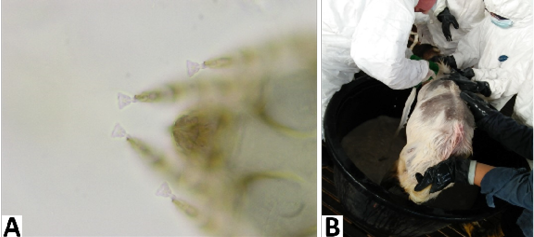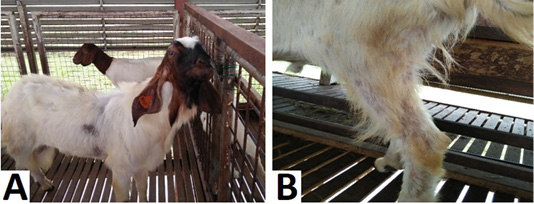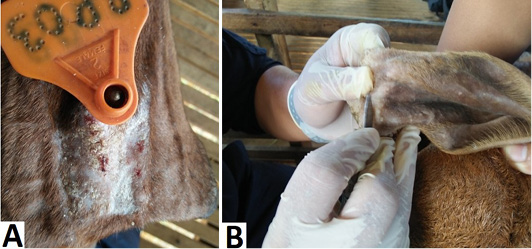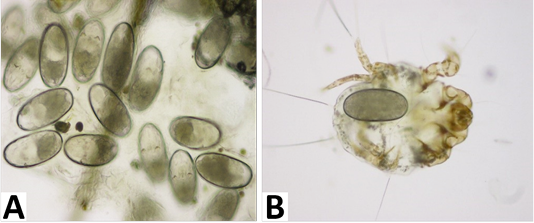Research Journal for Veterinary Practitioners
Case Report
Therapeutic Options in Management of a Clinical Case of Chorioptic Mange in a Goat
Faez Firdaus Abdullah Jesse1*, Idris Umar Hambali1,3, Yusuf Abba2,4, Muhammad Abubakar Sadiq2,3, Asinamai Athliamai Bitrus2, Eric Lim Teik Chung1, Mohd Azmi Mohd Lila2, Abd Wahid Haron1, Abdul Aziz Saharee1
1Department of Veterinary Clinical Studies; 2Department of Veterinary Pathology and Microbiology, Faculty of Veterinary Medicine, Universiti Putra Malaysia, 43400 Serdang, Selangor, Malaysia; 3Department of Veterinary Public Health and Preventive Medicine; 4Department of Veterinary Pathology, Faculty of Veterinary Medicine, University of Maiduguri, PMB1069, Borno State, Nigeria.
Abstract | A Jamnapari buck was presented during a farm visit with a history of skin itching and loss of hair. Physical examination revealed the presence of generalized skin lesions characterized by alopecic, crusty and pruritic dermatitis at bilateral hind limbs and ears. Deep skin scrapings was done and microscopical examination revealed the presence of Chorioptes mites. A definitive diagnosis of Chorioptic mange was made. Treatment was initiated with ivermectin (0.2 mg/kg), administered subcutaneously weekly, for 3 weeks, but the lesions still persisted.. Thereafter, treatment was carried out with Amitraz (0.05%) bath, weekly for 3 weeks. One week post treatment, the lesions resolved. In this case, Amitraz proved to be more effective in managing the Chorioptic mange infestation. Management of mange infestation may be challenging and warrant the use of several treatment options as was observed in this case.
Keywords | Skin lesions, Mange, Chorioptes mites, Ivermectin, Amitraz, Therapeutic option
Editor | Muhammad Abubakar, National Veterinary Laboratories, Islamabad, Pakistan.
Received | July 25, 2016; Accepted | August 20, 2016; Published| September 05, 2016
*Correspondence | Faez Firdaus Abdullah Jesse, 1Department of Veterinary Clinical Studies, Faculty of Veterinary Medicine, Universiti Putra Malaysia, 43400 Serdang, Selangor, Malaysia; Email: jesseariasamy@gmail.com
Citation | Jesse FFA, Hambali IU, Abba Y, Sadiq MA, Bitrus AA, Chung ELT, Lila MAM, Haron AW, Saharee AA (2016). Therapeutic options in management of a clinical case of Chorioptic mange in a goat. Res. J. Vet. Pract. 4(2): 39-41.
DOI | http://dx.doi.org/10.14737/journal.rjvp/2016/4.2.39.41
ISSN | 2308-2798
Copyright © 2016 Jesse et al. This is an open access article distributed under the Creative Commons Attribution License, which permits unrestricted use, distribution, and reproduction in any medium, provided the original work is properly cited.
Mites are small arthropods belonging to the subclass Acari and class Arachinida. They live freely in the soil or water but large number of species live as parasites on animals and plants with about 48,200 species described (Demite et al., 2015). Mange also known as Scabies is actually a disease caused by mites that burrow into animal skin to reproduce, it is characterised by scab development, severe itching and loss of hair and in rare cases transmissible to man (Jarmuda et al., 2012). Mange mites are ectoparasites with a significant importance usually resulting into economic downturn mostly in leather producing companies (Asmare et al., 2016). Several species of mites can infest goats but the most common ones are the Demodexcaprae (goat follicle), Sarcoptesscabiei (scabies mite), Psoroptescuniculi (psoroptic ear mite) and the Chorioptes bovis (chorioptic scab) (Seid et al., 2016). Transmission is through a direct contact with affected animals or contaminated fomites. The diagnosis of mange is usually through biopsy or skin scrapings, they cannot be viewed with a naked eye so they are confirmed with the aid of a microscope. But generally the presence of mite and skin lesions completes the diagnosis. Scabies scrapings can be collected deep around scabs until blood oozes out, samples are then processed and viewed under the microscope to identify the mite (Chanie et al., 2010). Treatment of mange is mostly done using ivermectin at the dose of 0.2 mg/kg, doramectin at 200 µg/kg at weekly intervals (Leon-Vizcaino et al., 2001; Marimuthu et al., 2015). Many literature have reported that chemical dipping (0.05% diaznon, 0.1% phoxin, lime sulphur and triclorfon) is the most effective way of treating scabies in goats (Bates et al., 2005). In this case report, two chemotherapeutic agents were used to manage chorioptic mange infestation in a goat.
CASE HISTORY
An adult male Jamnapari goat was presented with the history of skin itching and apparent loss of hair around the hind limbs and ears. The vaccination and deworming status of the patient were up-to-date.
CLINICAL EXAMINATION
Upon examination, the goat was observed frequently rubbing its body against the wall of the pen (Figure 1A). Examination of the limbs revealed bilateral crusty lesions on the hind limbs (Figure 1B) and there were also hard crusty patches on both ears (Figure 2A).
DIAGNOSTIC WORKUPS
Skin scraping samples were collected from the affected regions (Figure 2B) and the samples were prepared and then examined under a light microscope at 40x and 100x magnification. Clusters of mite eggs were observed (Figure 3A), Active mites and a few female mites with an egg inside the body were also identified (Figure 3B). Examination of the mite pedicles revealed short pedicles and the presence of cup-shaped suckers on the legs (Figure 4A). Based on these findings, a definitive diagnosis of Chorioptic mange was made.
TREATMENT
Initial treatment was instituted with three weekly doses of ivermectin (0.2 mg/kg), subcutaneously as an ectoparasiticide. Unfortunately, one week after the treatment regime, the lesions of mange still persisted. Further treatment was thereafter instituted with Amitraz (0.05%) bath as topical ectoparasiticide (Figure 4B), weekly for 3 weeks. Examination of the goat after a week post-treatment revealed resolution of the lesions, hence a good prognosis.

Figure 4: A) Mite with rounded head and cup-shaped suckers; B) Bathing procedure with Amitraz (0.05%) starting from the head and ending at the tail region
DISCUSSION
Based on the clinical examination and laboratory findings, this case report was a definitive case of Chorioptic mange infestation. There was no evidence of pyrexia reported, which rules out the possibility of a systemic secondary bacterial infection, even though skin abrasions were apparent. The animal was stable but the frequent rubbing of the body on the wall of the pen might lead to exhaustion due to an expected drop in appetite and subsequent emaciation as reported by (Lughano and Dominic, 2006). Ivermectin, a broad spectrum non hygroscopic, semisynthetic, anthehelmintic, antiparasitic drug has been proven to be effective against endo and ectoparasites (Chanie et al., 2010; Cornall and Wall, 2015). In this case, ivermectin was used as ectoparasiticide at one dose weekly for three weeks (Marimuthu et al., 2015). The weekly interval of administration was simply to halt the parasite’s life cycle by inactivating the viable stages of the parasite on the animal (Lughano and Dominic, 2006), hence, avoiding the growth of the parasite to maturity.
Selective administration of ivermectin has been reported to be successful in treating mange infestation in goats (Leon-Vizcaino et al., 2001; Marimuthu et al., 2015). However, the treatment of Chorioptic mange with ivermectin has proved to be less effective in this study as lesions persisted even after the completion of the recommended treatment regime. This may be due to low systemic levels of the drug or due to re-infestation of the goat by mites from the environment (Demite et al., 2015). Mites can survive in the environment such as the wall of the pen, the bedding and floor for up to 12 weeks (Demite et al., 2015). Hence, spraying of the pens with acaricides after such treatments is of paramount importance in order to halt the reoccurrence of the parasitic infestation (Seid et al., 2016).
Scabs provide a safe haven for mites where they get protection and escape drug therapy. Subsequently they mature into adult and result in more infestation. In such kind of situation, topical treatment is strictly recommended (Tabassam et al., 2008). In this case, the use of Amitraz bath was able to successfully resolve the mange infestation in the goat(Brugger and Braun, 2000). The success achieved with the bath is because it was applied topically and Chorioptes mites are non-burrowing and surface living mites (Vieira et al., 2014). Amitraz generally has the ability to wash off scabs when applied topically as in this case, it washed off the layers of crusts and scabs which gave protection to the mites, thereby exposing the mites to the effects of Amitraz and their subsequent eradication.
CONCLUSION
In conclusion, ivermectin is an effective antiparasitic drug used to treat mange in goats, but in cases of re-infestation from the environment and/or presence of thick crusts and scabs, the use of topical bath with Amitraz proved more effective as it was able to wash off the scabs and resolve the condition as was observed in this case report.. Therefore, combination of ectoparasiticide drugs and compounds that can digest the layers of crusts and scabs is highly suggested in order to achieve an effective treatment regimen.
ACKNOWLEDGEMENTS
The authors wish to appreciate the management and staff of the University Veterinary Hospital (UVH) and Taman Pertanianuniversiti (TPU) of the Universiti Putra Malaysia (UPM) for their cooperation throughout the course of this case.
Conflict of interests
None to declare.
Authors’ contribution
All authors contributed equally and approved the final manuscript.
REFERENCES









